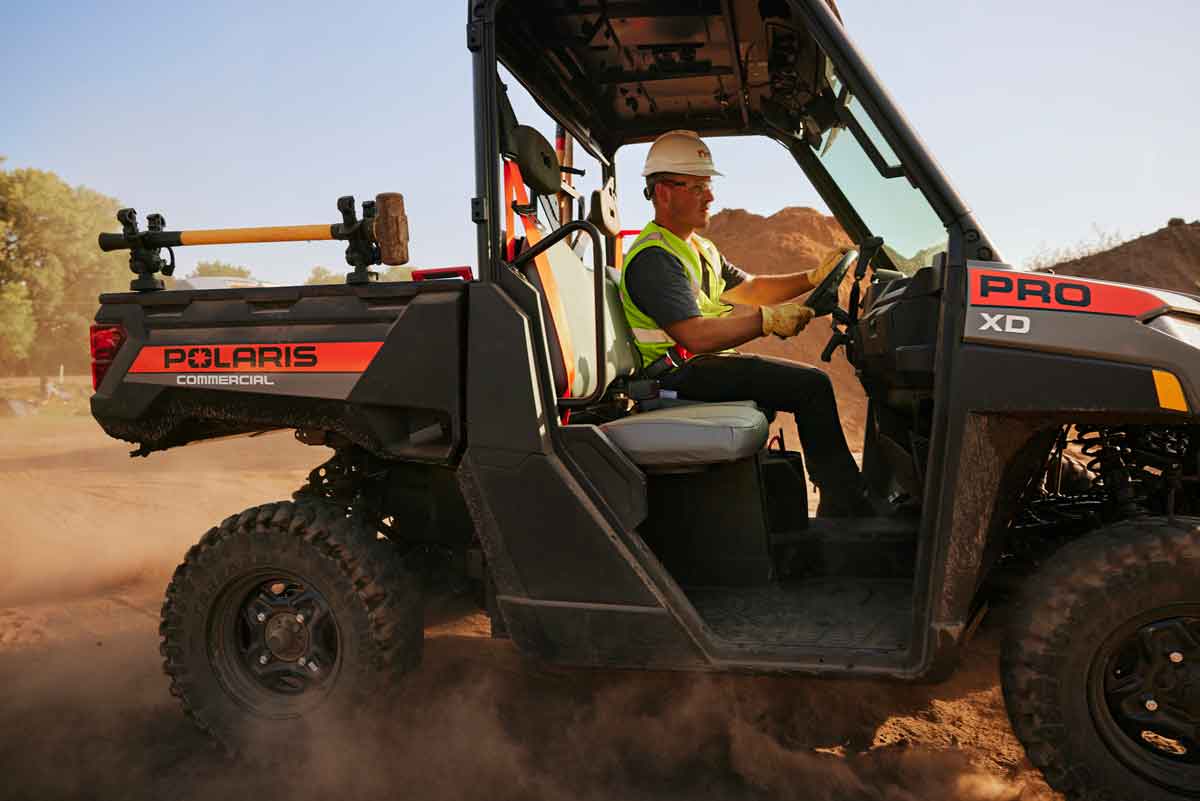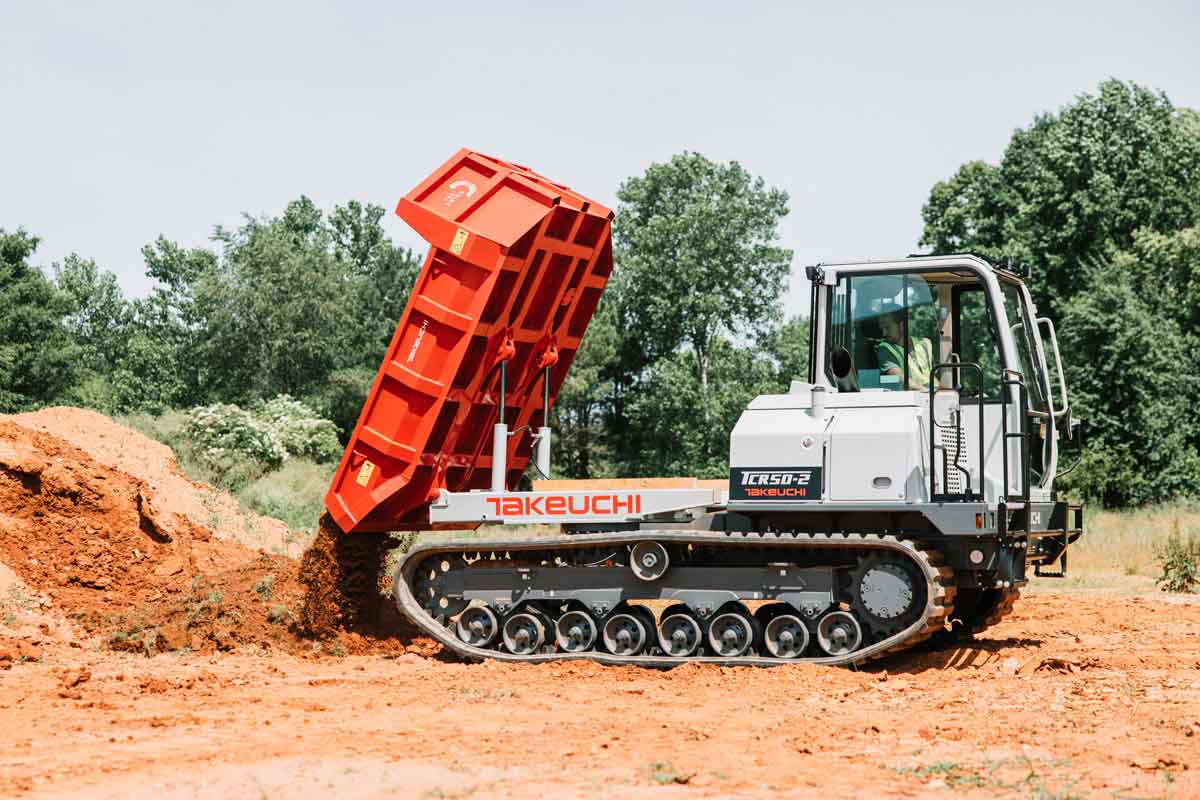Big Performance
Every piece of equipment in a contractor’s machine crew serves a purpose — whether it’s a skid steer, mini excavator or sweeper attachment — they all pull their own weight to get the job done. The same goes for a handy utility vehicle. This compact, sturdy and speedy creation helps crews move tools, materials and even each other back and forth to remote jobsites, aiding in the work process and a job well done.
In late August, Honda invited journalists to California’s very own picturesque Catalina Island, 26 miles off of the state’s coast, to take a look at and test drive its latest UTV offering — the Big Red multipurpose utility vehicle (MUV). Designed with Honda’s automotive history and experience in mind, the vehicle boasts features that make it an ideal workhorse, people mover and recreational vehicle all rolled into one.
“The Big Red was designed as a multipurpose utility vehicle,” explains Tim Patnode, media coordinator for Honda’s Motorcycle Div. “Farmers, hunters, contractors and recreational users alike can appreciate the Honda quality, reliability and functionality of this vehicle.”
Built with a sturdy frame, roomy cab, automotive-style features and a durable dump bed, the Big Red can fulfill the needs of both construction and landscaping crews looking for a compact work vehicle to zip around the jobsite. With a width of 64 in. and a height of nearly 70 in., the vehicle can access tight workspaces already crammed with other equipment.
Besides its compact dimensions, the Big Red also has a plethora of unique features to get drivers and passengers going whether it’s for work or play. The vehicle is powered by Honda’s liquid-cooled, four-stroke, single-cylinder, fuel-injected 675-cc OHV engine. An electronically programmed fuel injection system (PGM-FI), which uses a 40-mm throttle body, enhances the vehicle’s performance and delivers improved fuel consumption and faster engine warm-up.
To incorporate its automotive expertise, Honda included an automotive-style, three-speed automatic transmission with an electronic control module (ECM). A dash-mounted drive selector allows the driver to easily shift from two-wheel drive with open rear differential to four-wheel drive with rear differential lock or four-wheel drive with all-wheel differential lock. The ECM monitors vehicle functions such as speed (its top speed is 40 mph), gear selector position, brake application, etc.
“The Big Red has benefited from Honda’s considerable ATV and automotive technology and engineering,” says Patnode. “Honda took what it has learned regarding vehicle design and safety and then purpose-built the Big Red MUV.”
To further emphasize Honda’s automotive influence, Patnode points out the vehicle’s radiator. While the lightweight, aluminum radiator is automotive in regards to specifications, it’s designed and built for the rigorous movements of the MUV and is mounted high enough to avoid damage from trail debris. The vehicle also has four-wheel hydraulic disc brakes similar to automotive-style brake systems.
The Big Red is built with a double-wishbone suspension providing 10.3 in. of ground clearance to allow the driver to cross over rugged terrain and debris. Its specially designed tires (25 x 10-12) offer additional ground clearance and eliminate the need for extra spares.
Start a RiotPolaris Teams with ATV Web Site to Showcase its Vehicles at the Second-Annual Sand Riot Polaris Industries will present the second-annual Sand Riot in conjunction with H-Bomb Films, Friday, Nov. 21 to Sunday, Nov. 23 at the Glamis Beach Store in Imperial Sand Dunes-Glamis, Calif. This three-day event will include demos of the 2009 Polaris Outlaws and RANGERs, as well as other customized Polaris vehicles. All ATV and side-by-side enthusiasts are welcome to attend this kid-friendly event, which will also feature live disc jockeys and bands, vendors, a kid zone, giveaways and Polaris and H-Bomb factory racers. |
Workin’ It
With distinctive automotive features and a sturdy design, the Big Red definitely fits the bill for a useful, work-purposed vehicle. Ideal for contractors who need to move materials around the jobsite, the vehicle features a large tilt dump bed tough enough to accommodate most project requirements — whether the materials include additional tools and building materials for a construction project or mulch and dirt to complete a landscape. The dump bed is constructed out of a durable steel frame and covered with a molded polypropylene top plate. It also boasts a carrying capacity of 500 lbs, giving it the ability to move large loads.
The vehicle is designed with a progressive-action strut system assist to allow for simple cargo deployment. To make unloading materials from the bed even easier, tilt-release handles are located on both sides of the bed so they are more accessible to either the driver or passenger.
For additional cargo-moving capabilities, the Big Red features a 2-in. receiver-style hitch and a 1,200-lb towing capacity. With this attribute, contractors can get vital equipment and tools onto the jobsite with ease and by using a compact maneuverable machine — without the need for a larger pickup congesting a tight workspace.
To add the 2009 Big Red to an equipment fleet, the vehicle costs $11,399 for the standard red model. Honda also offers the vehicle in a Natural Gear camouflage for $11,899.
Taking It to the Streets Club Car Introduces Street Filling the tanks of multiple vehicles and equipment is tightening budgets and creating woeful sighs as the price per gallon continues to creep up. To help lessen the blow, Club Car has introduced a new line of electric low-speed vehicles (LSV) for those who need to hit the road without paying the high price of fuel. This zero-emission, Carryall LSV line is now recognized as street-legal in many states — opening the paths of transportation to areas other than trails and jobsites. Described by the National Highway Transportation and Safety Administration as “four-wheeled vehicles with a maximum speed greater than 20 miles per hour, but not greater than 25 miles per hour” that meet federal safety requirements, LSVs are an environmentally-responsible alternative to gas-guzzling trucks and automotive style vehicles used primarily by facility managers and maintenance staff on campus-like environments. In the past, utility vehicles used for maintenance, groundskeeping or other purposes at sites like these had to be kept off of the streets. Facility managers were not legally allowed to drive utility vehicles on public roads, which hindered access to many areas. Managers had few options other than pickups, vans and other automotive solutions, often using a vehicle that was larger than necessary. Street-legal LSVs have addressed that problem. Smaller than trucks or traditional automotive products, Carryall LSVs help users work in places other vehicles are too large to reach. They are able to maneuver and travel in smaller spaces than most other vehicles. As a result of their size, capabilities and power source, LSVs help increase efficiency and productivity, while at the same time providing a more eco-friendly alternative that saves cost on fuel. Standard features on the LSVs include cab enclosures, safety belts, hydraulic disc front and drum rear four-wheel brakes, DOT radial tires, lighting packages with headlights, turn signals and back-up lights, bucket seats and heavy-duty front bumpers. The vehicles are being sold through a newly established channel of authorized Club Car LSV dealers. |
Safety and Comfort Zone
When operating any piece of equipment, especially when driving in a utility vehicle, safety and comfort are important. In order to keep drivers and passengers safe when roaming around, Honda designed its MUV with an abundance of safety points — many mirroring Honda’s automotive heritage.
“A host of safety features were incorporated into Big Red. The one that is probably most evident is the strong and uniquely-designed occupant protection structure [OPS],” says Patnode. A four-pillar, six-piece OPS was devised to offer a sturdy exoskeleton for both the driver and passenger in the event of an accidental tip-over.
To further build off of the automotive inspiration that Honda used in the design of the Big Red, the engineers opted to use three-point Emergency Locking Retractor seat belts that are angled and speed sensitive, much like those utilized in street vehicles. Automotive-style door latches and an automotive-type, self-adjusting parking brake add to the list of safety features the vehicle possesses.
With demanding work schedules requiring contractors and crews to be on the jobsite for long hours, comfort is important when zipping around in a utility vehicle. To ensure that drivers and passengers stay comfortable and focused while out and about, the minds at Honda added features to produce a smooth and comfy ride.
Comfort begins with the Bid Red’s cab and its seats. The semi-bucket, rubber-mounted seats are adjustable and offer a comfortable spot to sit. The driver controls are within easy reach to the operator and access to 12-volt power is provided through a waterproof accessory socket that is placed between the vehicle’s seats.
“Good ergonomics are a hallmark of Honda products,” says Patnode. “Good ergonomics combined with a quiet automotive-type transmission and double-wishbone suspension produce a machine you can use all day long.”
An ergonomically-placed handlebar allows the passenger to comfortably hold on tight when driving over rough areas or down steep hills.
Aside from driver comfort, Honda designed the vehicle to allow for easy maintenance. By lifting the dump bed, the driver has trouble-free, open access to the machine’s high-mount air filter box to address any issues and maintenance. The Big Red also features a maintenance-free, 12-volt, 12-amp battery and the vehicle’s oil dipstick access point is conveniently located under the driver’s seat.
Whether a driver’s purpose for the Big Red is for work or recreation, the vehicle’s build, features and automotive-style characteristics make it a good fit for many applications. With Honda’s automotive ingenuity and experience blended into a multi-purpose utility vehicle, the Big Red can tackle tough terrain to transport tools to a construction jobsite or roam through the woods for a mid-afternoon joyride.
Pam Stask is assistant editor of Compact Equipment, based in Peninsula, Ohio.





Comments are closed here.